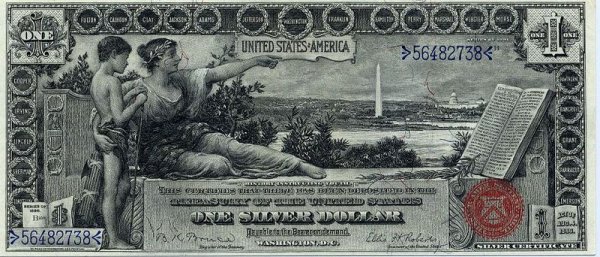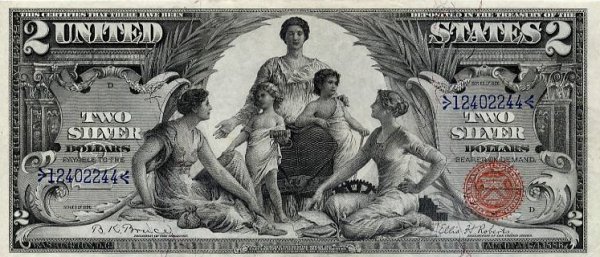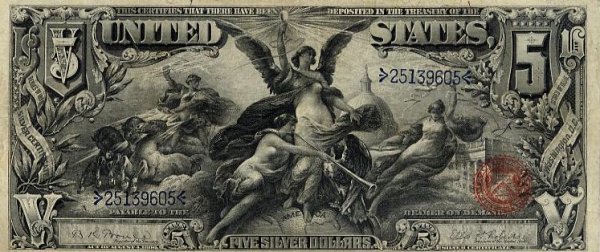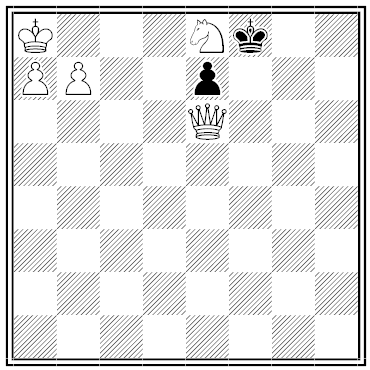“Those who wish to appear wise among fools, among the wise seem foolish.” — Quintilian
Spin Control

We’re playing Russian roulette. The revolver has six chambers, all empty. I put bullets in two adjacent chambers, spin the cylinder, hold the gun to my head, and pull the trigger. It clicks. Now it’s your turn. Before pulling the trigger, you can choose to spin the cylinder again or leave it as it is. Which is better?
“A Magic Circle of Cubes”

Reading this circle clockwise produces the numbers 04, 20, 34, 12, 50, 42, 03, 41, 53, 15, 31, 25.
Reading it counterclockwise gives 05, 21, 35, 13, 51, 43, 02, 40, 52, 14, 30, 24.
The sum of the first group equals that of the second, and this holds true if the numbers are squared or cubed. Further, if the numbers in the first group are arranged in ascending order and those in the second in descending, then:

(Devised by D.R. Kaprekar in 1956.)
Art and Commerce
In 1896 the U.S. Treasury introduced some beautifully high-minded currency — instead of American presidents, the “educational series” of silver certificates bear neoclassical allegories:

On the $1 note, the Goddess of History instructs a youth, pointing to the U.S. Constitution, a panorama of Washington D.C., and a roster of famous Americans, including Franklin, Longfellow, Hawthorne, and Emerson.

On the $2 note, Science presents Steam and Electricity (as children) to Commerce and Manufacture. The back bears portraits of Robert Fulton and Samuel Morse.

The almost impossibly glorious $5 note depicts Electricity Presenting Light to the World. She is flanked by Strength, Fame, and Peace. The New York Times wrote, “The arrangement of this composition, the grace of pose in each figure, and the idea connected with the designs of this artist entitle it to a place beside the finest allegorical designs in the world.”
Unfortunately, the Treasury got a new secretary the following year, one who favored simple, clear designs, and he canceled more than $54 million in certificates as they came into the Treasury. “It can be said authoritatively … that no more of the so-called ‘new certificates’ will be printed,” the Times reported sadly in May 1897. “Neither will fresco painters be called in to make designs for the substitutes.”
(Thanks, Stephenson.)
No Smoking

In 1874 John Thomas suggested a novel way to keep a locomotive’s smoke out of the passenger cars: a jointed pipe would carry the smoke the length of the train and release it harmlessly in its wake.
Smoke and sparks were a real danger on early railroads — in 1916 one Edson Hains filed a claim against the Wheeling & Lake Erie Railroad Company in Cuyahoga County, Ohio, for burning down his outhouse. The case is doubly memorable because Hains filed his pleading in verse:
Now comes the plaintiff, Edson Hains, and prays this august Court
To heed the very earnest plea, enshrined in this report.
The Wheeling & Lake Erie Co., a heartless corporation,
But licensed under certain laws of this fair State and Nation,
Did, by a spark through carelessness, from a locomotive owned
By the defendant in this Court, and by it not atoned,
Destroy and render Null and Void, a building situate
Upon the rear of premises, known as E. Hains Estate,
Which in the town of Bedford lies, a placid rural spot,
Until the conflagration, which spoiled the plaintiff’s lot.
The second of November last was the most woeful date
On which the said defendant did this outrage perpetrate.
Said building being plain but good, and open to all callers,
Was worth in money of the realm, the sum of fifty dollars.
Now, the aforesaid Hains will not cite Blackstone, Coke or Livy,
The incinerated building was, in vulgar terms, a privy.
The wealthy have from two to eight, but this case is more sad,
For like the poor man’s one ewe lamb, ’twas the only one he had.
And now in frigid winter’s time, before beginning labor,
He eke perforce must use the can of an obliging neighbor.
The plaintiff does still further state that he is an inventor,
And since the last catastrophe he has no place to center
His great inventive genius which, before in chaste seclusion
Of the before in mentioned can, did blossom in profusion.
True genius cannot be appraised, but plaintiff’s was so nifty
He thinks he should receive therefor at least one hundred fifty.
He therefore prays the Court to grant two hundred Iron Men,
That he may once more take his place midst Bedford’s upper ten,
And walk abroad midst citizens, and meet them man to man,
Which now he cannot rightly do, he being shy a can.
And so he prays that he may go from hence with compensation,
Commensurate with what he’s lost, through this his degradation.
And so he windeth up his prayer, and hopes the Court will grant
One fifty for his peace of mind, and fifty for the plant.
There’s a photostat of the pleading in John Allison Duncan’s Strangest Cases on Record (1940). Hains won — Judge William H. McGannon assessed the railroad $25 and costs.
Red Letters
‘All the world loves a lover.’ But in Venezuela, they do something about it. T.R. Lahey, in the Catholic periodical, Ave Maria, is responsible for the statement that the postal authorities there allow love letters to go through the mails at half price! But there is a condition. The letters must be mailed in bright-colored envelopes (pansy-blue for loving thoughts, and pink cloud effects; there would be a place for yellow and green to express the feelings of envious suitors and jealous lovers). These bright tints are intended to help the postal clerks and postmen to recognize the nature of the missives; but what a temptation to the carriers to open the letters and cull precious thoughts and phrases!
— The Lutheran, Nov. 6, 1940
Secret Entrance
Puzzle maven Noboyuki Yoshigahara noticed this sign on the glass door of an Osaka restaurant:

What is its meaning?
Counting …
Illinois State University mathematician Phil Grizzard points out that a person born on Nov. 30, 1999, is a “stopwatch baby” — the date always displays her age in months, days, and years. For example, today, 5/4/12, such a person has been alive for 5 months, 4 days, and 12 years. (Europeans can swap the month and day — the principle still works.)
A caveat: In December we must “make change” by setting the month to 0 and adding 1 to the year. So this Christmas, 12/25/12, a stopwatch baby will be 0/25/13 — 0 months, 25 days, and 13 years old.
Late Arrivals
Reiss records the death of a woman who was hastily buried while her husband was away, and on his return he ordered exhumation of her body, and on opening the coffin a child’s cry was heard. The infant had evidently been born postmortem. It lived long afterward under the name of ‘Fils de la terre.’ Willoughby mentions the curious instance in which rumbling was heard from the coffin of a woman during her hasty burial. One of her neighbors returned to the grave, applied her ear to the ground, and was sure she heard a sighing noise. A soldier with her affirmed her tale, and together they went to a clergyman and a justice, begging that the grave be opened. When the coffin was opened it was found that a child had been born, which had descended to her knees. In Derbyshire, to this day, may be seen on the parish register: ‘April ye 20, 1650, was buried Emme, the wife of Thomas Toplace, who was found delivered of a child after she had lain two hours in the grave.’
— George Milbry Gould and Walter Lytle Pyle, Anomalies and Curiosities of Medicine, 1896

